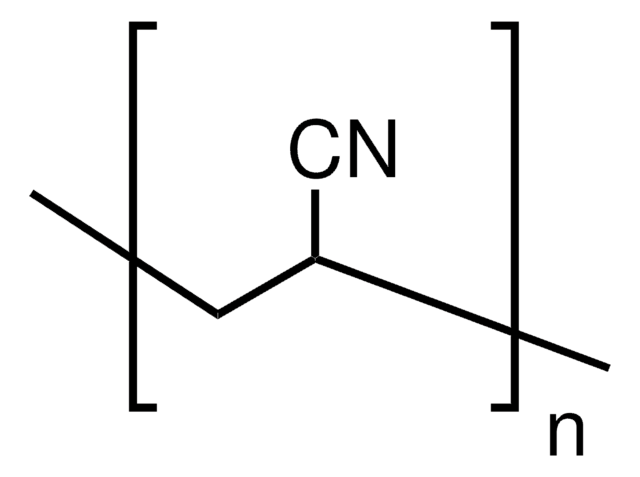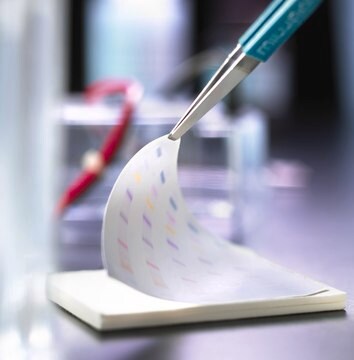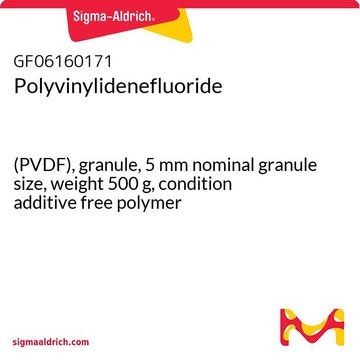Wszystkie zdjęcia(5)
Key Documents
182702
Poly(vinylidene fluoride)
average Mw ~534,000 by GPC, powder
Synonim(y):
PVDF
Zaloguj sięWyświetlanie cen organizacyjnych i kontraktowych
About This Item
Wzór liniowy:
(CH2CF2)n
Numer CAS:
Numer MDL:
Kod UNSPSC:
12162002
Identyfikator substancji w PubChem:
NACRES:
NA.23
Polecane produkty
ciśnienie pary
15 mmHg ( 32 °C)
Poziom jakości
Postać
powder
masa cząsteczkowa
average Mw ~534,000 by GPC
współczynnik refrakcji
n20/D 1.42
temp. przejścia
Tg −38 °C
Tm 171 °C
gęstość
1.74 g/mL at 25 °C
ciąg SMILES
FC(F)=C
InChI
1S/C2H2F2/c1-2(3)4/h1H2
Klucz InChI
BQCIDUSAKPWEOX-UHFFFAOYSA-N
Szukasz podobnych produktów? Odwiedź Przewodnik dotyczący porównywania produktów
Powiązane kategorie
Opis ogólny
Poly(vinylidene fluoride) PVDF is a semi crystalline non-centrosymmetric polymer which exhibits piezo-, pyro- and ferroelectric properties. It is a linear polymer that shows permanent electric dipoles perpendicular to the direction of the molecular chain. These dipoles result from the difference in electronegativity between the atoms of hydrogen and fluorine with respect to carbon. Depending on the processing conditions, PVDF exhibits several different crystalline phases (α,β,γ,δ). The β phase of PVDF is the phase that exhibits the best ferroelectric and piezoelectric properties.
Zastosowanie
Poly(vinylidene fluoride) (PVDF) is used in nanoporous electrodes. It is used to synthesize composites comprising of ultrafine fibers of PVDF embedded with carbon nanotubes. It can be used in sensors, actuators, for energy storage, sphygmomanometers, pressure sensors and nanogenerators, lithium ion batteries. Additionally, it may find application as matrix for PVDF-nanoclay nanocomposites and PVDF acrylic rubber/clay nanocomposite hybrid.
This page may contain text that has been machine translated.
Kod klasy składowania
11 - Combustible Solids
Klasa zagrożenia wodnego (WGK)
WGK 3
Temperatura zapłonu (°F)
Not applicable
Temperatura zapłonu (°C)
Not applicable
Środki ochrony indywidualnej
Eyeshields, Gloves, type N95 (US)
Wybierz jedną z najnowszych wersji:
Masz już ten produkt?
Dokumenty związane z niedawno zakupionymi produktami zostały zamieszczone w Bibliotece dokumentów.
Klienci oglądali również te produkty
Mohammad Mahdi Abolhasani et al.
PloS one, 9(2), e88715-e88715 (2014-02-20)
In this paper, intercalation of nanoclay in the miscible polymer blend of poly(vinylidene fluoride) (PVDF) and acrylic rubber(ACM) was studied. X-ray diffraction was used to investigate the formation of nanoscale polymer blend/clay hybrid. Infrared spectroscopy and X-ray analysis revealed the
Hot Plate Annealing at a Low Temperature of a Thin Ferroelectric P(VDF-TrFE) Film with an Improved Crystalline Structure for Sensors and Actuators.
Sensors (Basel, Switzerland), 14(10), 19115-19127 null
Chi Yan Lai et al.
Membranes, 4(1), 55-78 (2014-06-25)
Current commercial polymer membranes have shown high performance and durability in water treatment, converting poor quality waters to higher quality suitable for drinking, agriculture and recycling. However, to extend the treatment into more challenging water sources containing abrasive particles, micro
Wenzhong Ma et al.
Membranes, 4(2), 243-256 (2014-06-25)
The crystallization behaviors of two copolymers of PVDF were studied, and the effect of copolymerized chains on the crystallization behavior was investigated. The results indicated that both copolymers had a lowered crystallization temperature and crystallinity. The crystallization rate was improved
Thermal-to-electric energy conversion of a nanoporous carbon
Yu Q, et al
Journal of Power Sources, 183(1), 403-405 (2008)
Nasz zespół naukowców ma doświadczenie we wszystkich obszarach badań, w tym w naukach przyrodniczych, materiałoznawstwie, syntezie chemicznej, chromatografii, analityce i wielu innych dziedzinach.
Skontaktuj się z zespołem ds. pomocy technicznej






